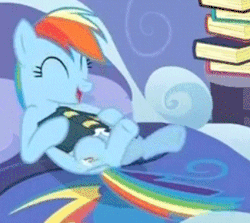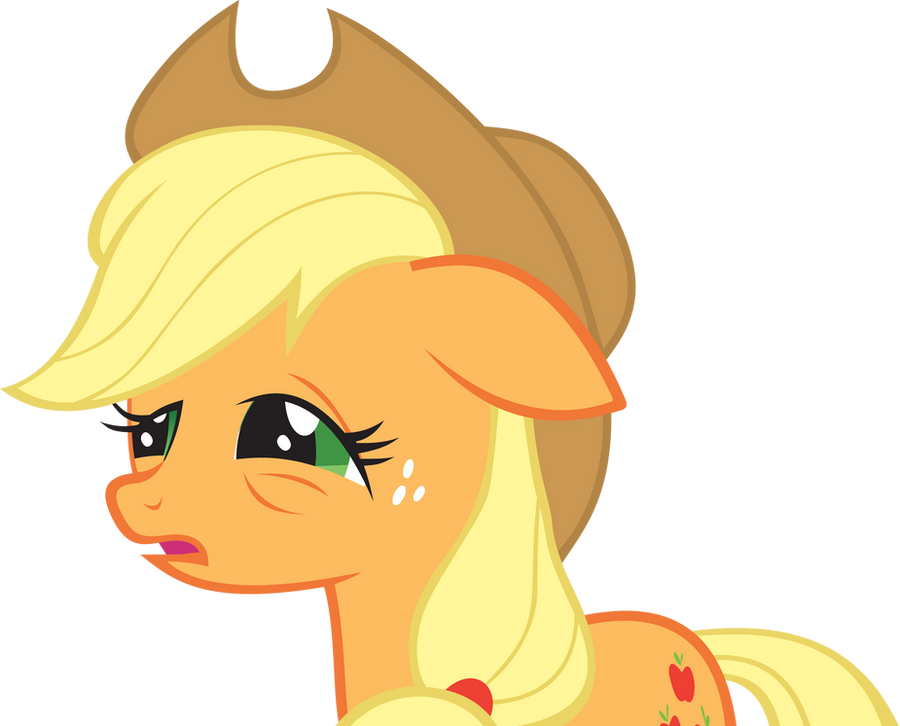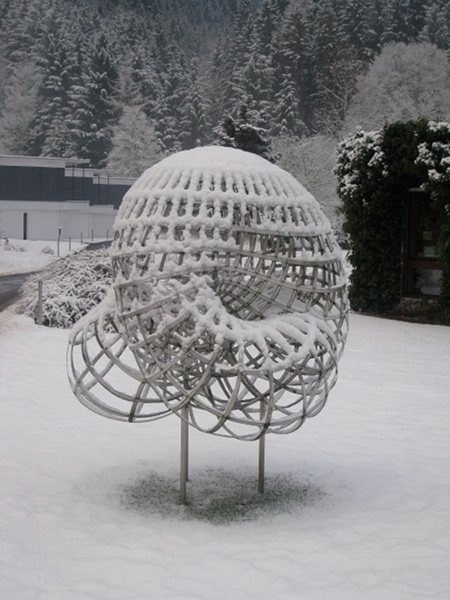So Rainbow Dash was like, "Hey Fluttershy, have you been doing exercises with the Zariski Topology recently? 'Cause you've got one affine variety right there."
(Fluttershy's reaction needs no further comment)
Nerdy jokes aside...
Today we'll be building projective spaces! Euclidean Geometry and Algebraic Geometry construct these spaces in different ways, so we'll do them both and look at how we can relate one to the other.
The space that gives us our familiar $n$-dimensional geometries, $\mathbb{R}^n$, is called the affine $n$-space over $\mathbb{R}$. You can also have affine spaces over an arbitrary field $\mathbb{F}$, but... we won't go there today.
The projective $n$-space over a field is the equivalence class of lines through the origin in the affine $n+1$-space over that field. Basically, we get rid of the origin, $\vec{0}$, and 'collapse' together each equivalence class of points in $\mathbb{F}^n \backslash \{\vec{0}\}$ under the equivalence relation $\vec{a_1} \sim \vec{a_2}$ iff $\vec{a_1} = \lambda \vec{a_2}$ for some $\lambda \in \mathbb{F}$. That's a bit abstract, so let's try to make this more intuitive. Let's just try to construct $\mathbb{RP}^2$ out of $\mathbb{R}^3$ for now.
Let's do some judicious collapsing: Instead of collapsing the entire equivalence class of $\vec{a}$ to a single point, let's just map each $\vec{a} \in \mathbb{R}^3$ to the point on unit sphere, $S^2$, corresponding to $\frac{\vec{a}}{||\vec{a}||}$
Note that the point we sent $\vec{a}$ to, $\frac{\vec{a}}{||\vec{a}||}$, is genuinely in the same equivalence class as $\vec{a}$ (as $\frac{1}{||\vec{a}||} \in \mathbb{R}$).
Note that I've only 'partially collapsed' $\mathbb{R}^3 \backslash \{\vec{0}\}$; each pair of antipodes (opposite poles) $a, b \in S^2$ are in the same equivalence class by $a = -b$.
So if the sun is the origin in $\mathbb{R}^3$, all ponies on the line connecting the sun to Rarity (excluding any ponies hiding in the center of the sun, but including any ponies hiding on the other half of the line, behind the sun) are mapped to the same point of $\mathbb{RP}^2$
For those who don't understand what this 'collapsing points' nonsense is all about: I'm defining a quotient map from one topological space to another. This happens in the same way you might 'stitch' one edge of $[0,1]\times [0,1]$ to another to make a a möbius band, or 'squash' $S^2$ into the closed unit disc of vectors of norm $\leq 1$ in the $xy$-plane. The way you 'collapse' the sides of $S^2$ into each other to form $\mathbb{RP}^2$ is
not something you can do in $3$-space... so if the precise shape of the thing we end up with is hard to visualize, that's why.
Since we're going to collapse one half of the sphere directly into the other, let's only worry about one half of the sphere for now (without worrying about what's going to happen to the equator). Let it be the half resting above the $xy$ plane, i.e. all $(x,y,z) \in S^2$ such that $z > 0$. "Project" the surface of the sphere (via the lines through the origin) onto the plane $z=1$, i.e. map each $(x,y,z)$ in this half of $S^2$ to $(\frac{x}{z},\frac{y}{z},1)$. This is a bijection between $\mathbb{R}^2$, i.e. the plane defined by $z=1$, and the open upper half of $S^2$. So $\mathbb{RP}^2$ is just like $\mathbb{R}^2$ if we leave out the stuff related to that equator in the $xy$ plane (note that these are the only equivalence classes of points that aren't defined by our map). Now what's so special about this equator? Time for a detour...
The way the projective plane is built from Euclid's axioms is that we take our affine plane, and for each equivalence class of parallell lines, we add a corresponding 'point at infinity'.
Note that in order for parallell lines to truly form equivalence classes, we have to let every line $l_1$ be parallell to itself (maybe 'lines that have the same slope' is the better term).
So these 'points at infinity' are sort of like a spot on the horizon. They're infinitely far away, but they occupy well-defined angles from the origin. Technically speaking though, it's a
pair of angles from the origin: the point where the lines $x=1$ and $x=2$ is both 'infinitely far up' and 'infinitely far down.'
Projective space sort of wraps around on itself. Additionally, the collection of points at infinity also form a 'line at infinity,' but
how they happen to form a line might not be obvious until we look back at our other construction...
This 'line at infinity' is precisely the equator of $S^2$ in the $xy$ plane that we couldn't map into the plane of $z=1$. And the 'point at infinity' that corresponds to the class of lines with slope $m$ will correspond to the points $\left( \frac{m}{\sqrt{m^2+1}},\frac{1}{\sqrt{m^2+1}},0 \right)$ and $\left( \frac{-m}{\sqrt{m^2+1}},\frac{-1}{\sqrt{m^2+1}},0\right)$ in the $xy$ plane.
It's a nice way of relating one model to another, but it still doesn't give you a visual understanding of what $\mathbb{RP}^2$ should look like once you actually collapse that equator together. The "shape" you'll end up with is what you'd get if you took a unit disc, and stitched its boundary circle to the boundary circle of a möbius band. In order to do that, your disc has to twist around and through itself. Again, regular surfaces in $3$-space are not allowed to do this. As I might have been hinting before, $\mathbb{RP}^2$, like the Klein bottle, can't be embedded in $\mathbb{R}^3$. They can do
immersions into $\mathbb{R}^3$, but not embeddings.
That's all for now. The next installment of $\mathbb{RP}^n$-related stuff will probably be about doing all that conic section tomfoolery in $\mathbb{RP}^2$. And maybe why $SO(3) \cong \mathbb{RP}^3$











